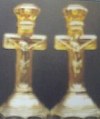Carnival Glass 101 | home Quick Reference to Carnival Glass Patterns on This Site
Diamond Glass - Part 1
DIAMOND GLASS COMPANY - Part 1
NOTE: As we all must realize, written accounts of history do vary somewhat, depending upon the authors' sources for research. Reference for this article: DUGAN & DIAMOND Carnival Glass by Carl O. Burns - 1909-1931, published 1999. His sources originated from old Dugan catalogues.
Huge amounts of marigold carnival glass were produced at Indiana, PA, but the vast majority of it was manufactured after 1913, under auspices of Diamond Glass Company management. Thomas Dugan made little marigold carnival. Berry sets, table sets, water sets, punch sets, etc. are to be found in marigold. However, in considering novelty type shapes such as bowls, compote, plates, nappies, etc., which comprise the bulk of his carnival production, we are presented with a very different picture. To illustrate the point, we shall list the full line of Dugan patterns found in complete sets.

All of these patterns which originated during the Dugan years, can be found in marigold.
Now we shall make a list of Dugan patterns found in novelty shapes.

Most of these novelty patterns are rarely seen in marigold. Some are nonexistent in that color. Most of them are found in peach opalescent, white, or amethyst. Only the Dugan patterns carried over into production by Diamond, or in designs which are specifically Diamond creations, do we note a significant marigold production.
About 90% of Dugan's carnival production centered around the above-described colors. He seldom ventured outside the five-color spectrum. A mere handful of Dugan pieces can be found in green carnival. A couple of wholesale catalog assortments in the 1911-1912 period, offer Target, Wide Rib and Pulled Loop vases in iridized green. There are three known Farmyard bowls in green carnival. Primarily the patterns introduced by Diamond after 1913 are the ones found in green.
The wholesale catalogs confirm that only during the last few months at Indiana, did Thomas Dugan produce cobalt blue carnival glass. Assortments of Dugan carnival including cobalt blue appear in the Spring of 1912. It was at that time that the Floral and Grape water set, Grapevine Lattice water set, and the Grape Delight rose and nut bowls first appeared. “Royal” iridescent was the trade name used to market the cobalt blue. Thomas Dugan departed the scene of operations within a year of this date. The bulk of blue carnival was produced by Diamond after 1913.
Examples of Pulled Loop, Target, and Dogwood Sprays have been found in vaseline opalescent and blue opalescent, but these are so rare that they must be classed as experimental.
The other carnival colors made at Indiana, PA - aqua, olive green, celeste blue, ice blue, sapphire blue, ice green, and true red, were developed after 1913 by the Diamond Glass Company.
On February 5, 1912, these headlines appeared in The Indiana Evening Gazette:
FIRE CAUSES $20,000 LOSS
Early Morning Blaze Devoured the Mold Shop and Large Quantity Of Expensive Molds
At The Dugan Factory
The fire virtually destroyed the machine shop at the plant, according to the report. This was the portion of the factory where molds were created, as well as stored. We must consider that while a $20,000 loss by today's standards is not all that great, by standards of 1912, it was catastrophic! The main production area of the plant was not affected. Thomas Dugan expressed in the article that they had been fortunate in that many molds had been in use on the main production floor at the time of the fire, and thus had been saved.
It became obvious that some carnival patterns which had been regularly featured in the wholesale catalogs vanished from them early in 1912, and never reappeared. For example, Ski-Star, Wishbone & Spades, Petal & Fan, Stippled Petals, and the Fishnet Epergne were not seen again.
The 1912 fire very likely explains the limited variety of carnival shapes produced in many patterns which were made in greater variety of non-iridescent shapes prior to the carnival era. The S Repeat pattern is a good example. It had been made in a variety of shapes prior to the carnival glass era. Perhaps the design was only in the beginning stages of production at the time of the fire, and the bulk of the molds were destroyed.
Certainly, it must have been a devastating blow to a great many of Thomas Dugan's best efforts and planning. It may well have been the crowning blow and contributing factor in his decision to leave Indiana, PA. We may never know the prevailing circumstances, but by January 1913, he had departed. The firm continued operation as the Dugan Glass Company until July of that year when the name changed to Diamond Glass Co.
Diamond's Carnival Glass Production, 1913 - 1931
The 1912 fire would certainly necessitate the need for the creation of new molds. Some, like Grapevine Lattice and Grape Delight, were created by Thomas Dugan in early 1912, and production of these designs continued. However, by 1913 we begin to see a new generation of patterns emerge from the Diamond Glass Company. A representative list of those patterns is quite revealing.

All of the above designs appeared for the first time, in wholesale catalogs or in Diamond advertising, after the departure of Thomas Dugan, so there is no doubt that he had virtually nothing to do with their creation. His absence clearly shows. Like the designs listed earlier that were all Dugan creations, these Diamond Glass Company patterns show many similarities, but they seem to lack the flow and graceful appeal so typical of Thomas Dugan's patterns. Somehow they are more awkward and hastily conceived. Some lack the attention to detail, which was typical of Dugan's work, and the high degree of relief is absent. This is not to say that Diamond designs are inferior. Many of them do present an appeal to collectors. We only present these differences, so as to point out the distinct pattern departures from the ones created by Dugan. At close comparison, the Dugan and Diamond designs are worlds apart.
With that in mind, you will not be surprised then, at the differences in the iridescent treatments applied to them. Again, these are not necessarily inferior in quality, they are just different.
Diamond produced a much wider variety of carnival glass colors than did the Dugan's. Considering that Thomas Dugan only produced carnival for a four year period, this is only logical.
Diamond's iridescent lines remained in production, in varying degree, for more than 17 years. Some of the carnival colors developed by Dugan remained in production for many years after his departure. Development of several new iridescent colors continued between 1913 and the late 1920s.
Diamond's Carnival Glass Colors, 1913 - 1931

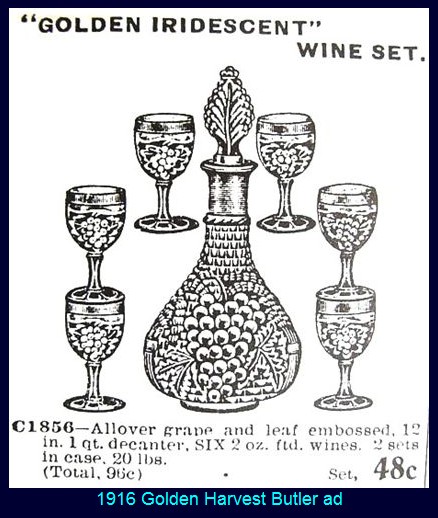
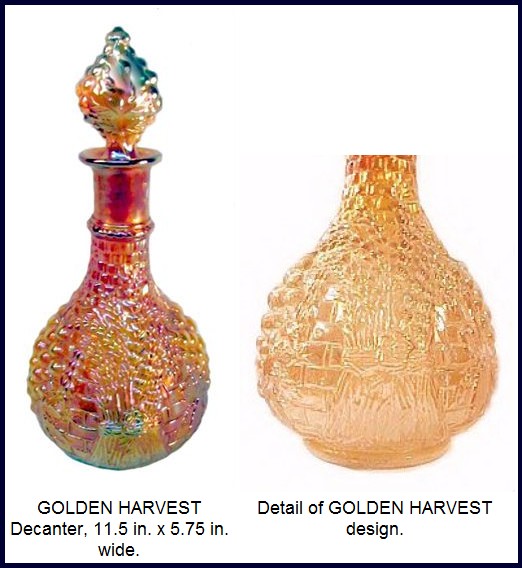
GOLDEN HARVEST: Shards were found in the Helman diggings, concluding that this interesting wine set was made in Indiana, PA. No other shapes are known to carry this pattern. The stemmed wines and decanter in this all over grape/leaf design first appeared in wholesale catalogs in 1916. The June issue of Butler Bros. catalog offered a marigold set, calling it “Golden Iridescent”. Neither marigold nor amethyst decanters turn up often. Wines are seen on occasion, with none of the pieces particularly well endowed with iridescence.
The pattern on this decanter is heavily embossed and the stopper is of solid glass. Close inspection of the wines will reveal differences from Imperial Grape wines.
Sets have been reproduced by L.G. Wright in amethyst. Gibson Glass has reproduced the decanters in electric blue and iridized custard. These are signed “Gibson” and often are dated.
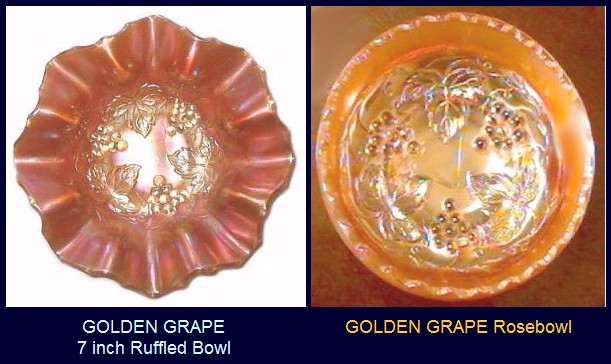
GOLDEN GRAPE: Production of this simple, but very pretty design was limited to 6”-7” bowls in marigold and amethyst, with marigold being rather plentiful. Only a few amethyst examples have been found. Green has been reported? Bowls may be either round or ruffled. Rose bowl shape, fashioned from the same mold is known in marigold, but these are rather scarce.
Typical of many latecomers from Diamond, the iridescence can be quite weak on these pieces.
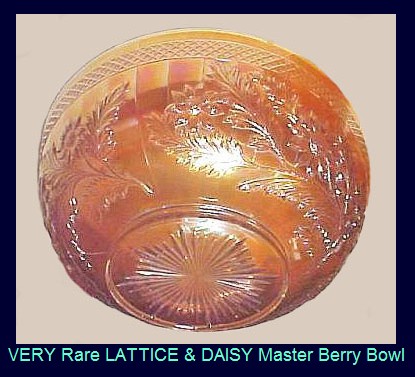
LATTICE & DAISY Berry Bowl: Master size berry is known in marigold, with only a handful known. The small berry bowl is no more plentiful. This set is the rarest of items known in this pattern. A small white bowl is known.
A whimsy vase in amethyst, fashioned from a tumbler is known. Tankards and tumblers in Lattice and Daisy are not plentiful at all. Marigold, amethyst, cobalt blue and white tumblers are known. Those same colors hold true for the tankards, except in white. Perhaps there is still one to be found?
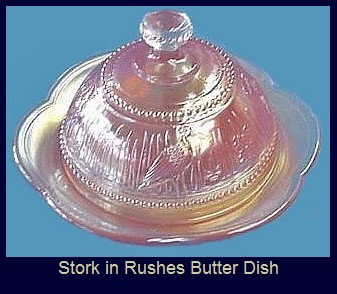
STORK in RUSHES Butter Dish: Table sets scarcely ever surface and have been seen only in marigold and amethyst. This design was the most extensive of Diamond's carnival lines. 16 different items have been documented, many of which are readily available. Others are extremely rare!
The pattern first appeared in wholesale catalogs in 1915, continuing through 1922. If you will click on ~~ ~~ in our pattern index, you will be taken to view other Stork in Rushes shapes.
~~ in our pattern index, you will be taken to view other Stork in Rushes shapes.
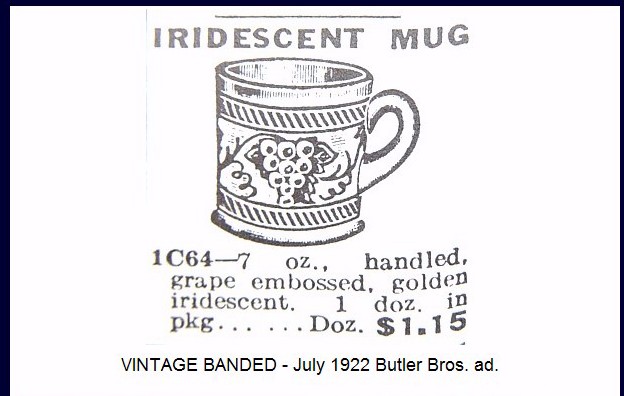
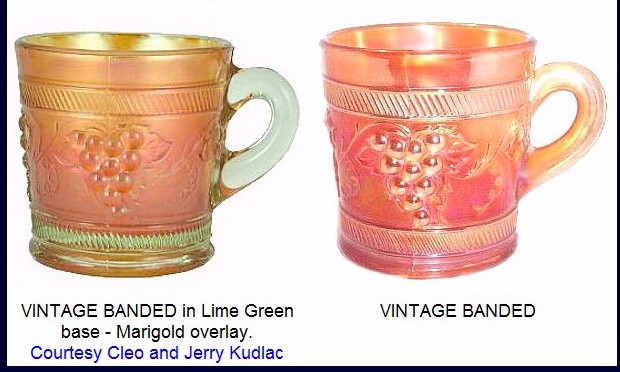
VINTAGE BANDED Mug: Some semblance to the design found on Dugan's Vintage perfume bottle and powder jar may be noted here. However, Vintage Banded is a later pattern, dating from Diamond production years. Wholesale catalogs were displaying it in 1922, continuing to do so through 1930, indicating a long production period. These mugs in marigold are easily found. Smoke examples are few and far between since smoke color was not used to any large degree by Diamond. (The time frame of production coincides with the bulk of Imperial's production of smoke colored items.) The unusual lime green base with marigold overlay is rarely seen! This type light green base glass is mindful of the After Glow series. In future, we will have a couple of segments surrounding this specialized carnival glass which is quite difficult to locate today.
A photo of what is said to be the only known amethyst mug appears in Dugan & Diamond Carnival Glass by Carl O. Burns. The water set in this pattern is rarest of all. We will discuss that in a later segment.
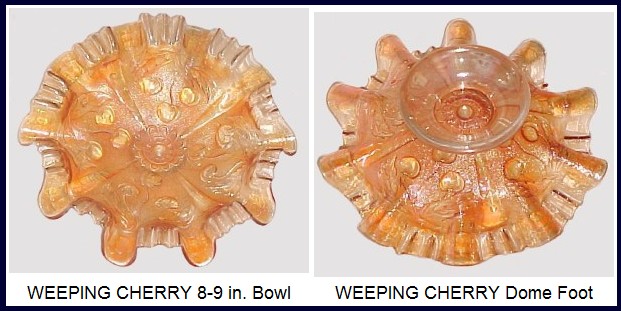
WEEPING CHERRY: Relative scarcity of this pattern, along with the known colors and mold characteristics, Weeping Cherry probably dates from the early 1920s. Found only on the interior of 8”- 9 1/2” dome-footed bowls, three colors have been reported: marigold, cobalt blue and amethyst. Marigold bowls are scarcely ever seen, and cobalt blue ones should be classed as rarities, indeed! Rarer still are the amethyst examples, with fewer than half dozen known.
Edges found on these bowls will vary from the 3/1 seen here, to a ruffle type.
Overlooked and under priced by reason of their virtual obscurity, the rush to purchase the highly promoted “rarities” leave educated collectors with such as a Weeping Cherry bowl to “gloat over”! (smile) It is a very good case in point surrounding a handful of rarities worth watching for.
Dean & Diane Fry - 6/07

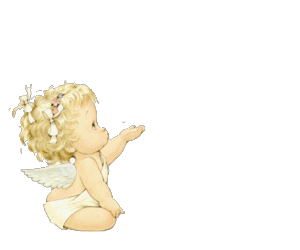
Should you care to contact the Frys, their email address is:
Search Our Sites
back to Carnival Glass 101
Our other sites you may enjoy:
Everything you EVER wanted to know about Indiana Glass
Great Reference for Newer Carnival Glass.
Complete Glassware Catalogs Available to Download
Questions? Comments? Suggestions? Broken Links? Corrections?
Your Friendly Webmaster is here to help!
